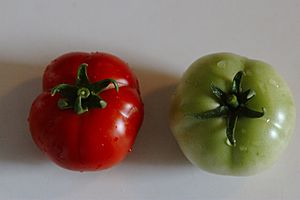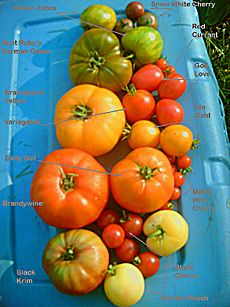Early Girl facts for kids
Quick facts for kids Early Girl |
|
|---|---|

Ripe and unripe Early Girl fruits
|
|
| Tomato (Solanum lycopersicum) | |
| Maturity | 50 days |
| Type | Hybrid |
| Vine | Indeterminate |
| Plant height | 9 feet |
| Fruit weight | 8 oz |
| Leaf | Regular leaf |
| Color | Red |
| Shape | Globe |
The Early Girl tomato is a popular type of tomato for home gardeners. It's known for growing fruit early in the season. Early Girl is a special kind of tomato called an F1 hybrid. This means it's created by crossing two different parent plants to get the best qualities from both.
This tomato is a cultivar with indeterminate growth. This means the plant keeps growing taller and producing flowers and fruit all season long. It will only stop when cold weather (frost) arrives. Because it grows so tall, it needs support, like a stake or cage. The fruit usually ripens in about 50 to 62 days after you plant it. This is great for places with shorter growing seasons. Early Girl can also handle cooler temperatures (around 40 °F (4 °C)) and hot, dry weather. It's a very dependable plant that produces lots of tomatoes!
The ripe Early Girl fruit looks like a typical tomato. It's about the size and shape of a tennis ball and weighs around 4 to 8 ounces (110 to 230 g). These tomatoes have a bright red color and a good flavor.
Contents
History of the Early Girl Tomato
How Early Girl Started
The Early Girl tomato was first developed in France. It was a special hybrid tomato designed to ripen quickly. In the early 1970s, a big seed company called PetoSeed Company brought it to the United States.
A person named Joe Howland from PetoSeed named the tomato "Early Girl." He wanted it to go well with their other popular tomato, the Better Boy. In 1975, another famous seed company, Burpee Seeds, got the special right to sell Early Girl for three years. They even put it on the cover of their spring catalog!
Who Owns the Seeds Now?
Since 2005, Monsanto Company has been the main producer of Early Girl seeds. They got the patent for this hybrid when they bought another company called Seminis. Even though it's a hybrid, the Early Girl plant is no longer protected by special plant patents. This means anyone can grow and sell its seeds.
Disease Resistance
Some Early Girl varieties are bred to resist certain plant diseases. For example, the Early Girl VF hybrid can fight off verticillium and fusarium wilt (strain I). The VFF hybrid is even stronger, resisting fusarium wilt strains I and II.
Growing Early Girl Tomatoes Without Much Water
What is Dry Farming?
The Early Girl tomato is very good for a special way of growing called dry farming. This technique means you don't water the plants much after they are first planted. Instead, the tomato roots are forced to grow very deep into the soil. They search for moisture on their own.
Benefits of Dry Farming
Researchers at the Center for Agroecology & Sustainable Food Systems at the University of California, Santa Cruz, have studied dry farming. They found that this method helps the tomatoes have a more "concentrated flavor." It also saves a lot of water, which is good for the environment.
Many people who love tomatoes really enjoy dry-farmed Early Girl tomatoes. Some even say they taste as good as the best heirloom tomatoes. You can often find dry-farmed Early Girl tomatoes at farmers' markets, especially in the San Francisco Bay Area. Home gardeners in that area also like Early Girl. It grows well there, even with the cool and often cloudy summers, which many other tomato types don't like.
A Famous Fan
Alice Waters, who started the famous restaurant Chez Panisse, is a big fan of the Early Girl tomato. She once told an interviewer that "one of the best tomatoes [she'd] ever had was an Early Girl that was dry-farmed up in Napa at a friend's house."


